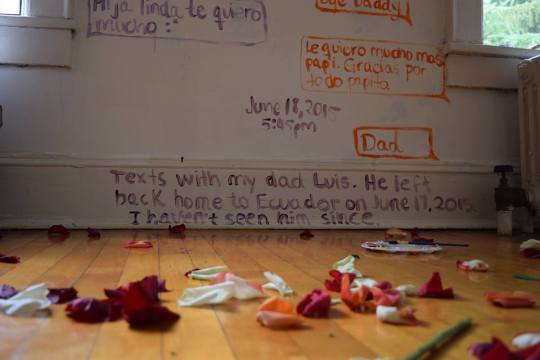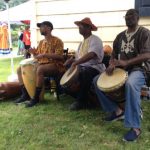‘Writing On It All’ Returns to Governors Island: An Interview with its Makers
“We have seen again and again that participants experience a kind of taboo-busting delight, a liberating disinhibition. This unmeasurable little thrill, a kind of micro-rebellion, provides an energy boost that affects how people approach these walls. People of all ages feel it.”
With successful programming in past summers, Alexandra Chasin’s liberating and beloved fiscal sponsorship project, Writing On It All, returns to Governors Island for its fifth season. Beginning May 27, this participatory and inclusive writing project brings dynamic colors, sketches, and forceful words to House 11 in Nolan Park on the 172-acre island in New York Harbor. Writing On It All gives visitors the chance to freely navigate through pressing themes utilizing the expressivity and materiality of writing and drawing.
The team behind Writing On It All’s programming includes Chasin, Zina Goodall, Stephanie Orentas, and Olga Rodríguez-Ulloa. In this interview, they share the motivations for launching the project as well as a few of the project’s most memorable moments.
NYFA: Writing and sketching on walls of one’s own house is typically a forbidden activity. However, it also conjures up feelings of adolescence, playfulness, and a sense of freedom. What led you to conceive of Writing On It All? Did any of these notions motivate you to create this program?
Writing On It All: We have heard again and again from participants that they have childhood memories related to writing on walls, whether pleasant or troubling. And, we have seen again and again that participants experience a kind of taboo-busting delight, a liberating disinhibition. This unmeasurable little thrill, a kind of micro-rebellion, provides an energy boost that affects how people approach these walls. People of all ages feel it. Nevertheless, kids dramatize the effect more unselfconsciously than adults, amazed that they are invited to mark up the walls and willing and able to jump into the activity to immerse themselves fully in writing and drawing. We were indeed motivated to design a writing experience that is inviting, inclusive, liberatory, and fun. However, the taboo-busting effect revealed itself through practice.
Writing On It All also supports our primary motivation to resist the exclusionary effects of writing and literature in schools and universities. The project invites all writers without concern for educational attainment. There is no code to master nor a secret handshake. We don’t evaluate the correctness or completeness of any resulting text. Basically, Writing On It All is a series of experiments in public participatory writing. When we define writing broadly enough and reduce barriers to participation, we create a radically inclusive writing practice.
NYFA: Your collaborators for Writing On It All include choreographers, poets, street artists, and domestic workers, among others. How did you develop such a diverse team? What are their roles in the project?
WOIA: The creative dynamism of Writing On It All depends hugely on the facilitators, those artists and writers who design and lead the sessions. No two sessions are alike, and no two facilitators are alike. We purposefully choose facilitators who work in a range of disciplines, media, and contexts.
We invite facilitators who have a record of teaching or some public-facing impulse in their work – we love supporting them as they develop public programming. We have worked with individuals, and also collectives, all of whom have in turn invited participants to experience writing as a collaborative and site-specific practice.
NYFA: Can you share any themes or pieces of writing that your participants have written that you or your collaborators cannot help but remember?
WOIA: Given the opportunity to install in a house, many of our artists have worked around themes of “home.” One session that stands out is Sonia Guiñansaca’s “Finding Home After the Migration.” Guiñansaca invited undocumented, formerly undocumented, and first-generation migrant artists and cultural workers to work behind closed doors to process the experience of migration and finding or creating “home” in this country. The work was beautiful, deeply personal, and revealing of the divisive nature of borders.
Another “home”-centered work, “If This, Then That” by Aisha Cousins, asked visitors to write the story of a fictional character trapped in the walls of the house after her family was pushed out of the neighborhood by gentrifying forces.
Kristiania Collective’s interactive panel on “The Art of Gentrification” featured DW Gibson, Nefertiti Macaulay, Alison Davis, and Suketu Mehta in conversation regarding New York’s increasing wealth gap and housing crisis. The audience was invited to take notes on the walls of a room, which kept an interchange of critical analysis alive for hours after the panel had finished.

NYFA: At the end of the project, the walls of the house are re-painted over and the writings are lost. Is erasure and ephemerality a core component of the project’s course of development?
WOIA: Yes, ephemerality is one of our core tenets, along with collaboration, materiality, and site-specificity. Writing On It All emphasizes the material nature of writing as a pushback against the Western cultural belief that ideas are pure spirit. Writers have bodies, texts are material objects, and writing is practiced through physical gestures. At Writing On It All, those gestures are larger than usual, our surfaces harder than usual, our materials bigger than usual. Participants are constantly in touch with the materiality of writing.
By the same token, writing and literature break down, degrade, dissolve back into dust. Even our most durable vehicle of text, the stone tablet, is ephemeral. At Writing On It All, we dramatize this by accelerating the erasure of the texts we produce.
This parameter of ephemerality also contractual: we have to paint over all the writing in order to return the house to its original condition.
NYFA: What is Writing On It All’s schedule for Summer 2017? How can one participate in a Writing On It All session?
WOIA: This summer, Writing On It All can be found in Nolan Park, House 11 at Governors Island. We will be open every Saturday, Sunday, and Tuesday from May 27 to June 25. Our hours are 1:00 PM to 4:00 PM. We have a house full of markers and paints, themes, prompts, fellow travelers, and blank walls, so all you have to do is show up! Here’s the schedule below:
May 27 to 29
Olga Rodriguez Ulloa & Alexandra Chasin
“Forms of Resistance (Literally!)”
June 4
Luis Jaramillo with Matthew Brookshire
“The Other Side: Borders and Crossings”
June 10
Ana Lara & LaTasha Diggs
“Here.”
June 11
Mariame Kaba
“Community Safety Looks Like: Transforming Justice and Our Relationships”
June 18
Laia Sole
KABOOM
June 24 and 25
Anthony Rosado
“TestOURmonials”
NYFA: Why did you choose NYFA Fiscal Sponsorship?
WOIA: We love working with NYFA because it is so supportive of artists’ vision and sustainability! Writing On It All is not yet large enough to seek non-profit status and relies heavily on donations and the creative network of New York artists. This makes NYFA’s fiscal sponsorship integral to the production of our annual season! We feel so supported in our effort to make participatory and interdisciplinary work. NYFA frequently guides us towards grants and other opportunities that lift up our process, allowing us to collaborate with and promote some incredible New York based artists.
Artistic Director Alexandra Chasin is Associate Professor of Literary Studies at Lang College, The New School. Chasin is the author of Selling Out: The Gay and Lesbian Movement Goes to Market (Palgrave Macmillan, 2001) and Kissed By (Fiction Collective 2, 2007), a collection of short fictions. Her novella, Brief, was first released as an interactive app and is available in print through Jade Ibis Press (2013). A past recipient of a NYSCA/NYFA Artist Fellowship, Chasin’s most recent book is Assassin of Youth: A Kaleidioscopic History of Harry J. Anslinger’s War on Drugs, a cultural history of drug prohibition (University of Chicago Press, 2016). Chasin holds an MFA degree in Writing from Vermont College and a Ph.D. degree in Modern Thought & Literature from Stanford University.
Program Director Zina Goodall is a producer and writer who has worked as a community organizer, circus performer, and teaching artist. Media and Communications Manager Stephanie Orentas is a manager and curator. Invited curator Olga Rodríguez-Ulloa is a researcher and cultural critic. To learn more about Writing On It All, please visit their website.
NYFA Fiscal Sponsorship’s next quarterly no-fee application deadline is June 30, and you can learn more about NYFA’s Fiscal Sponsorship program here. Read more about other exciting projects utilizing sponsorship, in our NYFA Fiscal Sponsorship Directory.
Interview conducted by Priscilla Son, Program Assistant, Fiscal Sponsorship & Finance
Images: Stephanie Orentas, Writing On It All





